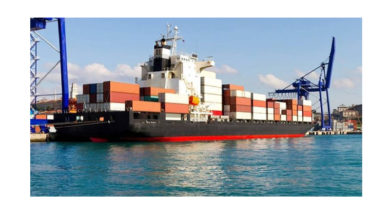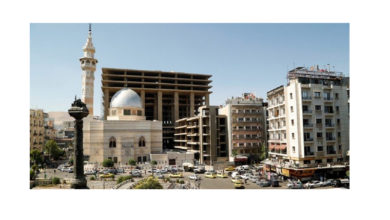Colours To Dye For
For textile printing we tend to think of flags and soft signage and T-shirts. But as Mike Horsten pointed out at a recent textile panel discussion and debate at FESPA Africa, the biggest market is in clothing, curtains, upholstery and lots of specialty applications as well.
However, printing for clothing (even shoes), curtains and everything else often requires inks other than dye sublimation. So today in the present article I will list all the inks for printing on fabrics, but will focus on traditional soft signage and flags. We can cover mass production of printed fabrics in a separate article.
Soft signage is hung so the fabric floats freely in the air. This is used in shopping malls and airports and convention centers (places with lots of space and high ceilings). Textiles printed for use for POP, point of purchase, would tend to be framed and often backlit.
Textile Ink List
Textile inks include: Acid dye ink, reactive dye ink, ublimation ink (Disperse dye for direct to fabric and dye sublimation for transfer paper to be heat pressed later) and Pigmented ink.
In theory you can also print on some kinds of fabrics with
 HP latex ink, UV-cured ink, Water-based ink in basic HP Designjet printers and Even solvent based ink.
HP latex ink, UV-cured ink, Water-based ink in basic HP Designjet printers and Even solvent based ink.
Reactive dyeinks, are for cotton and other cellulosic fabrics, silk, rayon, and wool. The Xennia site lists: cotton, linen, silk, and plant derived fibers such as hemp and jute. Note that silk can be printed with several different inks, depending on whether it is coated or not. Acid dye would be the normal ink for mass production printing on silk (not reactive dye ink).
So, in conclusion, reactive dye inks can be used for cotton, linen, rayon, wool, hemp, jute. And if absolutely needed, silk can be prepared to print with reactive dye ink.
Acid dye for silk and polyamide/Lycra® blends. DuPont says “nylon/elastane.” Xennia ink web site adds “even leather” though when leather is bent some inks will tend to flake off.
So, in conclusion: acid dye ink for silk, nylon, spandex, Lycra, any polyamide or elastane material; and perhaps leather if you are lucky!
Significant downside of acid dye and reactive dye is that you need a printing facility the size of a football field to hold all the pre-treatment and post-printing workflow equipment. Plus you need to budget for all these pre- and post-printing machines! This is why most printer and signage expos exhibit only dye sublimation printers, since all you have to do is sublimate the ink (though you can do more if you really wish to).
Pigmented ink is for pure cotton or a material which at least is predominantly cotton. Requires post-treatment in an oven or calendaring. DuPont claims their ink requires no fabric pretreatment. Yet some printer companies sell pretreatment machines.
Depending on your printhead brand and model, you would select a low viscosity ink, medium viscosity ink, or high viscosity ink.
Sublimation inks come in two main chemistries: printing on transfer paper, and printing directly to the fabric. In each case you still have to sublimate with heat (and pressure). Some of these inks can be solvent based, oil-based, or water-based. The first two have not been very popular.
When speaking of sublimation inks, normally you mention only disperse dye (for direct to fabric) or dye sublimation for printing onto transfer paper. At the recent textile discussion in Johannesburg, Mike Horsten mentioned the “high energy” variant of sublimation inks. The Xennia ink discussion also singles out this high energy variant and suggests it can be used for decorating lawn furniture (which must take a lot of direct sun).
Sublimation inks are for printing on polyester or materials coated with polyester.
You can also find “neon” ink in dye sublimation chemistry, which glows in the dark when you use a neon light on it. So for nightclubs or other comparable locations you can create impressive effects.
“Neon” ink is also available in lite-solvent and UV-cured kinds of inks.
UV-cured inks
UV Inks can print on technical textiles such as ARIA from Yeong Jeou. YJ has many years experience making technical textiles (PE primarily) for trampolines, carports, and now, for eco-friendly signage material.Also canvas and cotton.
Plus with a UV-cured printer you have white ink (so you can print onto a black fabric). And you have varnish, for spot varnish effects.
HP Latex Ink
Most HP booths at printer trade shows exhibit samples of wall coverings and fabrics printed with HP latex printers. You can see these samples this coming January at SGI 2016 (Sign Middle East, in Dubai).
Water-Based Inks
Water-Based Inks can print onto coated silk or other fabrics. But if they have an open weave, the fabric must be backed with a liner (or the ink will pass through the mess up the platen). I used to print silk from 3P with my HP Designjet 5000 and 5500 printers over a decade ago. But I have never seen any trade show booth promoting any such printer today. However HP latex ink area of their booth displays definitely promote printing on fabrics.
Just be aware that UV-cured ink and latex ink remain on the surface of the fabric. So you get an ink layer feel when your hand touches the textile. With true textile inks, the ink is down inside the fibers, so the “hand” is more fabric pleasant to your touch.
Solvent Ink
Ronald Van Den Broek(Mimaki) kindly answered my question about what fabrics you can print with a solvent printer. Naturally this would never be your first choice of ink or printer. But if the fabric is coated for solvent ink, and has a back liner (so the ink does not pass through the weave and mess up the platen and the back of your image), then in theory you can use a solvent printer.
Printheads
Every printhead can do some things nicely, other aspects okay, but is not capable of handling another aspect of the overall situation. Decide what speed you need, how much cleaning the printheads you can put up with. And be sure to visit and speak with an actual printing company who has used the printheads you are considering.
We recently learned that one reason the Aquajetmay have had problems was because of the particular model of the head: the brand was good, but that model may not have been ideal for the kind of textile ink being used.
If lots of printers use Ricoh heads; if lots of printers use Konica Minolta heads (for textiles), then this is a hint. But if you notice that one or two brands are simply never or rarely used in a textile printer, this might be a warning to be cautious and double-check before trusting that printhead model. But also realize that some printer factories stick with one brand because that way they get a lower price (and because their engineers know how to use that head well). There may well be a better head but if the engineers are content they will stick with their old-fashioned preference for ages (note how many printers still use the outdated and potentially obsolete Epson cartridges still today (even when they don’t use Epson heads anymore!).
RIP Software
Consider a RIP from a company which has plenty of experience with printing on textiles, such as Evolution RIP from Digifab in the USA. Any RIP can “handle” textiles but most RIP software is not focused on fabric printing. My GMC Suburban has 4WD but when I go on field trips in Guatemala to locate plants with natural latex, a Suburban would fall apart: a Mazda double-cabin 4WD is much better (not many people use Ford F250 4WD in Guatemala).
 Sadly the Gandinnovations textile printer did wonderfully in the demo room, but we gradually learned that it did not function as well out in the real world. The same with the textile printers from most UV-cured or solvent ink printer factories: they simply did not have the experience to make a textile printer. Now you can understand why efi bought Reggiani: Reggiani really knows textile printing inside out.
Sadly the Gandinnovations textile printer did wonderfully in the demo room, but we gradually learned that it did not function as well out in the real world. The same with the textile printers from most UV-cured or solvent ink printer factories: they simply did not have the experience to make a textile printer. Now you can understand why efi bought Reggiani: Reggiani really knows textile printing inside out.
I will be polite and not list the other elite brand names whose textile printers were not as good out in an actual print shop as they were in the demo room or in the factory. But even the absolute top prestige brands, their first textile printer was not a success! You can’t just use any printhead; you can’t just use any Roll-to-Roll transport system.
Of the Japanese brands, Mimaki by far has put the most effort into actually designing a textile-ready printer. Sadly, most of other brands simply take a solvent printer (or a UV printer) and jerry-rig it with a new model designation as a “textile printer.” For printing on transfer paper, a simple printer is not as much an issue. Where you need a sophisticated system is if you prefer to print direct-to-fabric and thus have to run the fabric through your printer. No normal printer can handle the ink or the stretchability of the woven or knitted material.
Be sure your graphic designer is aware of textile ink reality
Don’t try to do photographs with textile ink: a drawing looks much better. Don’t try to do any image with a lot of dark colors or lots of shadow: the details will be lost. And realize that some colors are brighter in textile ink, but a few colors may be muted.
Industry Trends
Fifteen years ago every lecturer at every industry conference predicted “textile printers were huge.” This never happened in these early years: I even gave a lecture over a decade ago explaining why these predictions for 2000-2010 were wishful thinking and PR bombasts. But in the last three years, the surge to textile printing has really happened, and it inches up every year (and will continue to do so).
 Efi recently purchased the impressive Italian textile printer company Reggiani MacchineSpA. Sensient ink company of Switzerland purchased the UK ink company Xennia. More consolidation will happen, and more ink companies will offer dye sublimation inks (especially now that the contested and thus potentially insecure patents for aspects of sublimation are expiring).
Efi recently purchased the impressive Italian textile printer company Reggiani MacchineSpA. Sensient ink company of Switzerland purchased the UK ink company Xennia. More consolidation will happen, and more ink companies will offer dye sublimation inks (especially now that the contested and thus potentially insecure patents for aspects of sublimation are expiring).
We respect patents if they are accepted as valid by people with experience in the industry. But a tricky patent, which is not respected by the industry, is not helpful for the overall industry. Once any uncertain patent expires, the cost of sublimation ink can drop down to what is justifiable and good for the entire industry.
What to look for?
This could also be called, “what to hope for”
• better color saturation for direct to garment printing with disperse dye inks.
• Better color pop for pigmented ink
• easier to use pigmented ink for mass production (for applications far beyond T-shirt printing.
Another dream is to have a material you can sublimate onto besides polyester. About every 5 years some ink company claims to have this, but these new inks never survive out in the real world.
FLAAR Reports writes about all these TRENDs in our textile coverage. You can write [email protected] either for Dr Hellmuth and Maria Renee Ayau as a consultant to come to your company anywhere in the world and/or to receive all the FLAAR Reports on textiles.
Where to learn about textiles: textile magazines?
We recommend the following specialty magazine, book, and/or web sites.
WTIN (World Textile Information Network)
Digital Printing of Textiles, edited by H. Ujiie was outstanding for its time (2006) but the ink chemistry and printer brands have long ago moved forward. His book lists the polyamide/Lycra® blends use, which we have expanded with less technical words.
Where to learn about textiles: trade shows?
The biggest textile printer expos in the world are:
• ITMA Asia (in China)
• ShanghaiTex (in China)
• ITMA Europe (this year in Milano)
There are also textile expos in India, Turkey, and Brazil, but none are as large as the three listed above.
FLAAR Reports attends ITMA Europe every time (every four years). We have attended ITMA Asia and ShanghaiTex, but since this year there is an ITMA in Milano, there is not much need to attend ShanghaiTex. ShanghaiTex surprised everyone by having noticeably more textile printers than even ITMA Asia.
Keep in mind that these “textile expos” are for textile weaving and knitting factories. So most booths show knitting and weaving machinery and every kind of machine used in a factory. But each year there are more and more inkjet textile printers on exhibit.
A textile expo will have many many more textile printers than FESPA, ISA, SGIA or any normal signage expo. A textile expo is so much better than Drupa there is no comparison. You can also experience many brands of textile inks at ITMA, especially ITMA Europe. Nonetheless, we highly recommend attending SGI (aka Sign Middle East) this coming January in Dubai, because here you can speak with the major printer manufacturers and distributors in your local area.
Further coverage and discussion of textile printing
Printing on T-shirts is a bit different than wide-format inkjet printing. We should to a separate future article on all aspects of T-shirt inks and workflow equipment.
Sublimation onto metal is also a potential topic. And it helps to learn about cutters for fabrics: not all cutters can handle woven or knitted material adequately.
But first I would like to do an article on heat presses, calendering machines, and transfer paper. Every distributor is eager to sell a “textile printer” but what you really need is to see the entire workflow. Nonetheless, inks and printheads and movement of the fabric through the printer are the first lesson to learn.
Summary on textile printing
Flags, soft signage, and backlit fabrics for POP are the most common applications printed by normal sign shops. Once you decide to print on rugs and carpets, this is a slightly different world (and may be best with special inks, and/or a flatbed printer).
You should also consider wall coverings, wallpaper, and murals with pertinent kinds of textiles. Just realize that if the sun shines on this wall every day, be realistic in the kind of ink you select, and what promise of longevity you provide the client. But I have photographs of mine, on the walls of sunlit rooms in tropical Guatemala, which have not lost any noticeable color in more years than I can count (but this is photo paper, with HP pigmented ink or comparable).





